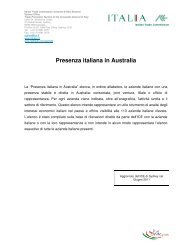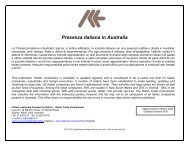Price Determination in the Australian Food Industry A Report
Price Determination in the Australian Food Industry A Report
Price Determination in the Australian Food Industry A Report
Create successful ePaper yourself
Turn your PDF publications into a flip-book with our unique Google optimized e-Paper software.
• Export markets have created growth <strong>in</strong> demand for fresh chilled carcass portions, yet <strong>the</strong><br />
carcass size sought for export markets is not compatible with domestic fresh markets, forc<strong>in</strong>g a<br />
portion of <strong>the</strong> export carcass <strong>in</strong>to <strong>the</strong> processed meat market.<br />
• Retail prices for pork products and cuts are subject to competition, <strong>in</strong> terms of price and<br />
consumer preferences for meat use, from o<strong>the</strong>r red and white meats.<br />
• The overall impact of <strong>the</strong>se different forces on carcass profitability has been to put downward<br />
pressure on net returns for pork processors and producers.<br />
• The upshot of <strong>the</strong>se divergent forces is to break <strong>the</strong> nexus between fresh meat retail prices and<br />
farmgate returns for <strong>the</strong> <strong>in</strong>dustry.<br />
• Feed is <strong>the</strong> major cost of production represent<strong>in</strong>g 60 per cent <strong>in</strong> pig meat production <strong>in</strong> normal<br />
conditions. The recent surge <strong>in</strong> feed costs as a consequence of higher world prote<strong>in</strong> costs and<br />
<strong>the</strong> drought <strong>in</strong> Australia saw producers forced to meet very high costs of production, with no<br />
commercial avenue to recoup such costs from <strong>the</strong> customer due to <strong>the</strong> pressure on prices from<br />
imported product. Imports had enhanced competitiveness due to <strong>the</strong> ris<strong>in</strong>g value of <strong>the</strong><br />
<strong>Australian</strong> dollar.<br />
Figure 45. Pork: Major drivers of prices and costs<br />
The pork value cha<strong>in</strong> has been under significant cost pressure <strong>in</strong> recent years due to its greater exposure to imported<br />
commodity products which are used <strong>in</strong> smallgoods process<strong>in</strong>g and <strong>the</strong> chang<strong>in</strong>g consumer product mix.<br />
1. Farm production factors<br />
• Production volume displays low<br />
short-term volatility.<br />
• Pigmeat production is seasonally<br />
based on fertility and economies of<br />
feed and pork prices.<br />
• Meat products are perishable with<br />
very limited shelf <strong>in</strong> life once<br />
slaughtered.<br />
2. Value-cha<strong>in</strong> <strong>in</strong>tegration<br />
• Increas<strong>in</strong>g alliance of production, abattoir and<br />
bon<strong>in</strong>g activities to more closely align pork to<br />
market use – but little or no <strong>in</strong>tegration exists<br />
beyond process<strong>in</strong>g through to market.<br />
• Returns from pork sector strongly <strong>in</strong>fluenced by<br />
returns from smallgoods co-products which<br />
consume about 60% of pig meat across a diverse<br />
set of products.<br />
• Increas<strong>in</strong>g scale efficiency <strong>in</strong> pig production and<br />
process<strong>in</strong>g is rapidly chang<strong>in</strong>g cost structures <strong>in</strong><br />
supply cha<strong>in</strong>s across <strong>in</strong>dustry.<br />
• Greater concentration of ownership of process<strong>in</strong>g<br />
facilities.<br />
3. The market<strong>in</strong>g approach<br />
• Limited product differentiation<br />
or de-commoditis<strong>in</strong>g compared<br />
to eat<strong>in</strong>g quality and new cut<br />
market<strong>in</strong>g <strong>in</strong>novations<br />
undertaken <strong>in</strong> o<strong>the</strong>r red meat<br />
categories.<br />
• Limited product brand<strong>in</strong>g.<br />
• Greater customisation of<br />
carcass and portion use <strong>in</strong><br />
different markets.<br />
Exports<br />
Bon<strong>in</strong>g<br />
Farm production Abattoirs Wholesal<strong>in</strong>g Retail<br />
Smallgoods manufactur<strong>in</strong>g<br />
4. Regulation and compliance<br />
• Increas<strong>in</strong>g costs of compliance<br />
with environmental, welfare and<br />
food safety requirements for<br />
pork producers and processors.<br />
• Strong community requirement<br />
for new facilities to be located<br />
fur<strong>the</strong>r from residential areas<br />
due to environmental factors.<br />
• Strong requirement to meet<br />
ethical and product <strong>in</strong>tegrity<br />
demands <strong>in</strong> export markets.<br />
Imports<br />
5. Trade impacts<br />
• Significant pressure from<br />
imported commodity<br />
carcass portions (<strong>in</strong> frozen<br />
form) <strong>in</strong> smallgoods sector<br />
of <strong>in</strong>dustry affects overall<br />
carcass returns.<br />
• Strong <strong>in</strong>fluence of<br />
prevail<strong>in</strong>g world commodity<br />
prices for pig meat (as a<br />
threat to domestic market<br />
returns).<br />
• Moderate <strong>in</strong>fluence of <strong>the</strong><br />
growth <strong>in</strong> export volumes <strong>in</strong><br />
carcass and cuts. This has<br />
an impact on <strong>the</strong><br />
compatibility of residual<br />
carcass profitability <strong>in</strong><br />
domestic markets.<br />
• Strong <strong>in</strong>fluence of<br />
prevail<strong>in</strong>g commodity prices<br />
for feed gra<strong>in</strong>s.<br />
6. Technology and<br />
<strong>in</strong>novation<br />
• Increas<strong>in</strong>g capital<br />
<strong>in</strong>tensity is chang<strong>in</strong>g cost<br />
structures <strong>in</strong> production<br />
and process<strong>in</strong>g.<br />
• Limited transparency of<br />
market prices and costs.<br />
• Greater <strong>in</strong>vestment <strong>in</strong><br />
<strong>in</strong>novation to improve<br />
overall carcass return<br />
through match<strong>in</strong>g to<br />
market requirements.<br />
<strong>Food</strong> service<br />
7. Retail market dynamics<br />
• Greater demand for<br />
convenience and lifestyle<br />
solutions <strong>in</strong> <strong>the</strong> eat<strong>in</strong>g<br />
grades and cuts of meat<br />
products is affect<strong>in</strong>g<br />
competitiveness of <strong>the</strong><br />
pork category.<br />
• Greater specification of<br />
retail products requir<strong>in</strong>g<br />
smaller carcass size.<br />
• <strong>Price</strong> competitiveness<br />
based on competition<br />
between meat cuts.<br />
• Greater concentration of<br />
<strong>the</strong> retail markets for<br />
pork products <strong>in</strong><br />
supermarkets.<br />
<strong>Price</strong> <strong>Determ<strong>in</strong>ation</strong> <strong>in</strong> <strong>the</strong> <strong>Australian</strong> <strong>Food</strong> <strong>Industry</strong> A <strong>Report</strong><br />
49







